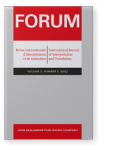Vol. 5:2 (2007) ► pp.23–38
Study on Job Satisfaction and Directions for the Training of Conference Interpreters
Le présent article traite des résultats d’un sondage effectué auprès des interprètes de conférence en Corée du Sud et à l’étranger sur la satisfaction du métier et les motivations qui poussent à continuer à travailler comme interprète de conférence.
Les interprètes ont répondu qu’ils travaillaient comme interprètes de conférence pour les raisons suivantes : (1) C’est mon métier ; (2) J’apprends beaucoup ; (3) J’aime m’impliquer dans la communication.
Ceux qui envisageaient un changement de carrière ont cité les raisons suivantes : (1) Il n’existe aucune opportunité de promotion ou de développement de carrière ; (2) Je suis toujours obligé de véhiculer le message d’autrui ; (3) Je suis toujours obligé de travailler avec des gens différents.
A la question « quel genre de travail vous voulez combiner avec les activités d’interprétation ?», les interprètes coréens ont répondu leur souhait d’enseigner, tandis que beaucoup d’interprètes occidentaux ont répondu qu’ils souhaitaient écrire ou s’engager dans les négociations. A la question « quelles seraient les matières à enseigner aux interprètes de formation ? », les sondés ont répondu (1) techniques de présentation, (2) techniques de négociations, (3) techniques d’écriture. Il est intéressant de noter que la plupart ont répondu que les interprètes, étant des experts dans la communication des messages, il était important qu’ils apprennent à produire et à communiquer de manière efficace leurs propres messages également.
References (11)
Cited by (3)
Cited by 3 other publications
This list is based on CrossRef data as of 2 july 2024. Please note that it may not be complete. Sources presented here have been supplied by the respective publishers. Any errors therein should be reported to them.
